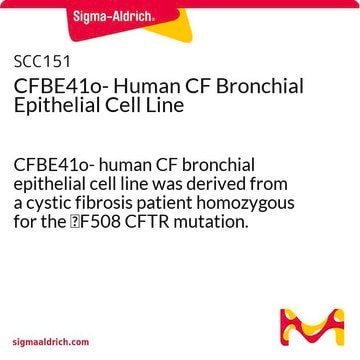SCC160
CFBE41o- 6.2 WT-CFTR Human CF Bronchial Epithelial Cell Line
Human
Synonim(y):
CFBE41o, CF41o, CFBE
About This Item
Polecane produkty
product name
CFBE41o- 6.2 WT-CFTR Human CF Bronchial Epithelial Cell Line, CFBE41o- 6.2 WT-CFTR human CF bronchial epithelial cell line is used to study the relationship between CFTR mRNA expression and Cl transport function.
pochodzenie biologiczne
human
metody
cell based assay: suitable
cell culture | mammalian: suitable
Warunki transportu
ambient
Opis ogólny
CFBE41o- 6.2 WT-CFTR Human CF Bronchial Epithelial Cell line is a subclone derived from the electroporation of the parental CFBE41o- cell line with an Epstein-Barr virus (EBV)-based episomal pCEP4β vector containing the 6.2 kb full length wtCFTR cDNA and a Hygromycin B resistance gene . The 6.2kb wtCFTR cDNA contains both the 5’ and 3’ UTR sequences that are known to affect translational efficiency and mRNA stability. The parental CFBE41o- is a CF human bronchial epithelial cell line, derived from a CF patient homozygous for the ΔF508 CFTR mutation and immortalized with the origin-of-replication defective SV40 plasmid (pSVori-) .
In CFBE41o- 6.2 WT-CFTR cells, the levels of vector-driven wt-CFTR mRNA were found to be significantly higher than endogenous CFTR mRNA levels in normal 16HBE14o- bronchial epithelial cell (Cat. No. SCC150). However, cAMP-dependent Cl currents generated in CFBE41o- 6.2 WT-CFTR cells were not as high as those observed in 16HBE14o- cells, which express endogenous CFTR. Established CF bronchial epithelial cell lines that are complemented with either wild-type or ΔF508CFTR mRNA would help provide insights into the relationship between transgene-derived CFTR mRNA expression and rescue of cAMP-dependent Cl transport function.
Opis linii komórkowej
Zastosowanie
Jakość
• Cells are tested by PCR and are negative for HPV-16, HPV-18, Hepatitis A, C, and HIV-1 & 2 viruses as assessed by a Human Essential CLEAR panel by Charles River Animal Diagnostic Services.
• Cells are negative for mycoplasma contamination.
• Each lot of cells is genotyped by STR analysis to verify the unique identity of the cell line.
Przechowywanie i stabilność
Oświadczenie o zrzeczeniu się odpowiedzialności
Unless otherwise stated in our catalog or other company documentation accompanying the product(s), our products are intended for research use only and are not to be used for any other purpose, which includes but is not limited to, unauthorized commercial uses, in vitro diagnostic uses, ex vivo or in vivo therapeutic uses or any type of consumption or application to humans or animals.
Kod klasy składowania
10 - Combustible liquids
Klasa zagrożenia wodnego (WGK)
WGK 1
Temperatura zapłonu (°F)
Not applicable
Temperatura zapłonu (°C)
Not applicable
Certyfikaty analizy (CoA)
Poszukaj Certyfikaty analizy (CoA), wpisując numer partii/serii produktów. Numery serii i partii można znaleźć na etykiecie produktu po słowach „seria” lub „partia”.
Masz już ten produkt?
Dokumenty związane z niedawno zakupionymi produktami zostały zamieszczone w Bibliotece dokumentów.
Produkty
16HBE14o- human bronchial epithelial cells used to model respiratory epithelium for the research of cystic fibrosis, viral pulmonary pathology (SARS-CoV), asthma, COPD, effects of smoking and air pollution. See over 5k publications.
16HBE14o- ludzkie komórki nabłonka oskrzeli wykorzystywane do modelowania nabłonka oddechowego w badaniach nad mukowiscydozą, wirusową patologią płuc (SARS-CoV), astmą, POChP, skutkami palenia tytoniu i zanieczyszczenia powietrza. Zobacz ponad 5 tys. publikacji.
Nasz zespół naukowców ma doświadczenie we wszystkich obszarach badań, w tym w naukach przyrodniczych, materiałoznawstwie, syntezie chemicznej, chromatografii, analityce i wielu innych dziedzinach.
Skontaktuj się z zespołem ds. pomocy technicznej








